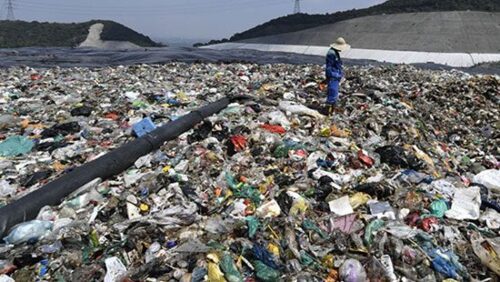Observing the Conditions of Overseas Waste Processing Sites
The United States has Undergone the Closure of the Old Landfill and the Opening of a New Landfill
The landfill does not only exist in Indonesia. In fact, the landfill was recorded for the first time operating at the Fresno Municipal Sanitary Landfill in California, United States, in 1937.
According to a news quote from Liputan6.com in 2019, Indonesia is alleged to have approximately 400 landfills with only 10% of them operating optimally. The United States has a total of approximately 2000 landfills that are still active, while many other landfills have been declared inactive and have converted into public parks.

Most of the landfills in America occupy the West Coast, even Staten Island was once one of the largest landfills in the world.
The Largest Landfill in the United States
The Puente Hills Sanitary Landfill in Los Angeles, California, is one of America’s largest landfills with a dump height of up to 500 feet (150 meters / 40-story building) on 700 hectares of land. Opened in 1957 and taken over by Sanitation Districts in 1970, the Puente Hills landfill was declared out of operation since October 31, 2013.



To anticipate landslides, rubbish in the Puente Hills Sanitary Landfill is compacted and formed in terraces. According to historical records, one way to deal with rat pests in Puente Hills is by compaction the garbage, so that the rats can die from being crushed or run out of oxygen.
In addition to the Puente Hills Sanitary Landfill, here is a list of the 30 largest landfills in the United States, along with the amount of waste managed each year and the last estimated year of operation:



Produksi Gas Metan (CH4) dan Sampah Makanan di TPA Amerika Serikat
For more than 80 years, residents of the United States have gone through a series of risks and benefits from closing old landfills and opening new landfills or revitalizing and reclaiming. No different from Indonesia, the United States is also currently struggling with the issue of methane gas (CH4) emissions in landfills.



Currently, TPA in Texas and California are still the 2 states of the United States that produce the most methane gas (CH4), which is one of the greenhouse gases that can accelerate the depletion of the ozone layer.
The high production of methane gas (CH4) is allegedly due to the large amount of food waste that has accumulated in the landfill, especially with the fact that the United States has 913,246 total cattle and calf farms (NBCA.org) that produce feces and animal waste, the source of methane gas.
According to the globalcitizen.org article, residents of the United States generate three times the waste that the world’s population generates annually. With a fairly high waste production and a recycling rate of only 35.2% (Germany holds the highest waste recycling rate at 56.1% in 2020, Indonesia is still below 10%), the United States is also still looking for the best solution to reduce the amount of waste which ended up at the TPA.masih mencari solusi terbaik untuk mengurangi jumlah sampah yang berakhir di TPA.
China is Starting to Move to Reduce Waste in Their TPA
China manages its waste by two main methods: waste processing in landfills and incineration. According to 2017 data, China has 654 landfill locations and 286 waste incineration facilities.
China’s Largest Landfill is Overcapacitated 10 Years Faster
The Jiangcungou landfill in the Shaanxi region, which is about 100 times the size of a football field, was declared full and no longer operational 10 years earlier than expected. This is because the Jiangcungou landfill waste acceptance limit, which was originally only 2500 tons per day, has increased to 10,000 tons per day, so that the Jiangcungou TPA, which was originally intended to last until 2044, is estimated to have overcapacity more quickly.



China is one of the largest waste-producing countries in the world. According to a study from Jenna Jambeck in 2016, China is the largest contributor to marine debris in the world (Indonesia ranks second). Realizing that the country’s waste management situation is quite urgent, China has started enacting regulations to increase recycling and reduce the amount of waste. Some of them are eliminating waste imports in 2017 and enforcing regulations for sorting waste into 4 types (recycled waste for example bottles and cans, B3 waste, organic waste, and other waste) in Shanghai in 2019.
China Stopped Importing Garbage in 2017
According to data from the Chinese statistical agency, Chinese residents produce approximately 0.72 kg of waste every day. There is no clear data yet on what China’s recycling rate is, but China plans to recycle 35% of the waste generated annually. This is quite surprising, considering that China imports a lot of waste from other countries to support their recycling industry.
In 2017, China stated that it stopped accepting imported waste from other countries, and even tried to return the collected waste. Some types of waste that China has no longer accepted since the end of 2017 are post-use plastic waste, textile waste, as well as residual ash containing arsenic or metal.
Given the number and length of time China has received imports of waste from other countries over the years, China’s decision has had a significant impact on the waste management system of many other countries, namely the UK, the United States, and several countries in Asia.
China Combats Food Waste Production That Ends in Landfill
Earth.org data shows that China produces 25% of the world’s waste and most of it is food waste. This prompted his government to start considering the Clean Plate Campaign policy in August 2020, which is to reduce the production of food waste by ensuring that Chinese people consume enough food and don’t waste food.



Some of the Clean Plate Campaign methods according to the nytimes.com article may be misinterpreted by the Chinese people, namely the existence of a restaurant that places a body scale which will determine how much food guests can eat as well as provisions for disqualification of scholarships for students who eat more food than they should. The existence of the Clean Plate Campaign method which has an authoritarian impression, invites questions and speculation about the real purpose of the campaign.
The Chinese government states that the Clean Plate Campaign is intended to reduce the amount of organic waste that ends up in the landfill, but several sources predict that perhaps the appearance of the Clean Plate Campaign is due to the COVID-19 pandemic that began taking place in China since the end of 2019 and has had an impact on the agricultural industry and distribution of foodstuffs in China. Not to mention the big floods in China in July-August 2020 which in addition to claiming many lives also damaged agriculture.
Sweden Managed to Ensure Less than 1% of Its Waste End up in the Landfill
Sweden is among the countries that have achieved a recycling rate of up to 47% (the highest was Germany with a recycling rate of 56.1% in 2020). The waste management system in Sweden is among the most efficient and effective, so they have to import waste to keep the recycling industry going.
In the early 1990s, Sweden had 400 landfills, but currently, the number has decreased to 140. Most of the residual waste of Swedish residents are processed in 34 incineration facilities or Waste to Energy facilities spread across Sweden. It said the 2,000 tonnes of residual waste incinerated at the WTE Sweden facility could produce the energy equivalent of 670,000 tonnes of petroleum. For countries with cold climates, the energy diverted for heating and electricity is of course very important.



The incineration and waste-to-energy processes had sparked controversy because incineration was said to be not recycling and the process of burning waste was allegedly still releasing a number of hazardous substances into the air. Some sources have indeed stated that the incineration process at the Swedish Waste to Energy facility is said to be safe and minimizes the number of dioxins released into the air, but the fact that Sweden is said to receive waste incineration services from other countries also invites quite a number of pros and cons.
Miljönär-vänlig: Next Steps to the Recycling Invitation
In Indonesia and many other countries, we hear a lot of calls to recycle: from explaining the importance of recycling to offers to exchange recyclable waste for some money. However, Sweden has taken the next step to further implement the 3R (Reduce-Reuse-Recycle) and circular economy concepts, namely an invitation to completely avoid recycling by applying the concepts of repairing, sharing, and reusing.



Miljönär-vänlig itself is a combination of words which means millionaires and the environment, namely the concept that a person can become rich economically while saving the environment by getting used to the culture of repairing, sharing, and reusing before spending money to buy goods. new.
Swedish Support Forms for the EU Commission Program to Implement a Circular Economy
The reduction in the number of landfills and a reduction in the amount of waste that ends up in landfills in Sweden is also alleged to be support for the EU Commission program, one of which is targeting a ban on the accumulation of recyclable materials in landfills by 2025 and reducing the amount of waste that ends up in landfills. to less than 10% by 2030. This EU Commission agreement aims to apply the circular economy concept to every country that is part of the EU Commission.
Be a Pioneer, Not a Follower
There are many things that we can conclude from the experiences of other countries in managing waste in their TPA (Read also: Countries with Interesting Waste Management Systems). Not all of them have to be followed, there are some things that we can find our own solutions to suit Indonesian culture and needs.
End of pipe waste management, which adopts collect-transport-dumping, is no longer effective. At present, almost all countries are advised and are competing to immediately apply the principle of a circular economy in business and industry. Apart from extending material life, reducing the consumption of non-renewable natural resources, it is also to reduce waste that ends up accumulating in the landfill – all of which aim to improve and prevent further environmental damage.
Learn from the United States, which has for years closed and opened new land for landfills, China, which used to receive imported waste from other countries and is currently struggling to reduce the pile of garbage in its country, also Sweden which has been successful in reducing the amount of waste that ends up in the landfill but still looking for solutions to find other energy sources if there is no more waste that can be burned, we can find the best way for Indonesian people who still need a lot of education about the importance of sorting waste and not dumping waste illegally into the environment.
One thing is for sure, it takes collaboration from the government, the private sector, the community, and all-important stakeholders for a successful waste management revolution.
Waste4Change supports all steps towards better waste management by providing services for holistic waste management solutions, from education, campaigns, consulting, transportation to recycling. Waste4Change has experience in projects that involve waste-to-energy research, procurement of organic waste management systems, education for coastal communities for the introduction of ecotourism, and research on waste materials for recycling. Waste4Change supports zero-waste to landfill, 3R (Reduce-Reuse-Recycle), and a circular economy for a more responsible Indonesian waste management system.
Source:
- https://www.bbc.com/indonesia/majalah/2012/06/120604_brazil_rubbish_closesam.shtml
- https://www.bbc.com/news/world-asia-50429119#:~:text=China’s%20largest%20dump%20is%20already,any%20landfill%20site%20in%20China.
- https://www.fastcompany.com/3062853/these-maps-show-how-much-of-the-us-is-covered-in-landfills#:~:text=There%20are%202%2C000%20active%20landfills,Fresno%2C%20California%2C%20in%201937.
- https://www.globalcitizen.org/en/content/us-landfills-are-filling-up/
- https://www.saveonenergy.com/land-of-waste/#:~:text=A%20Tale%20of%20Thousands%20of%20Dumps&text=The%20circa%201937%20Fresno%20Municipal,and%20future%20landfills%20followed%20suit.
- https://www.liputan6.com/lifestyle/read/3902025/cerita-akhir-pekan-setumpuk-masalah-tempat-pembuangan-akhir-sampah-di-indonesia#:~:text=Di%20Indonesia%20ada%20lebih%20dari,persen%20yang%20beroperasi%20secara%20maksimal.
- https://www.theatlantic.com/technology/archive/2013/04/touring-the-largest-active-landfill-in-america/274731/
- https://www.triplepundit.com/story/2016/fixing-americas-waste-problem/23506
- https://theprint.in/world/is-china-running-out-of-food-xi-jinpings-clean-plates-campaign-is-causing-rare-anxiety/486317/
- https://www.nytimes.com/2020/08/21/world/asia/china-food-waste-xi.html
- https://reason.com/2020/08/22/china-announces-authoritarian-campaign-to-combat-food-waste/
- https://sweden.se/nature/the-swedish-recycling-revolution/
- https://www.independent.co.uk/environment/sweden-s-recycling-is-so-revolutionary-the-country-has-run-out-of-rubbish-a7462976.html



